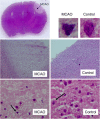Characterization of a new model of thromboembolic stroke in C57 black/6J mice
- PMID: 24347404
- PMCID: PMC4092233
- DOI: 10.1007/s12975-013-0315-9
Characterization of a new model of thromboembolic stroke in C57 black/6J mice
Abstract
This study characterizes a new model of thromboembolic stroke of the middle cerebral artery in C57 black/6J mice, thus offering an opportunity to use the model for studying ischemic stroke in transgenic mice. Thromboembolic stroke was induced by local injection of either 1.5 or 3.0 UI of thrombin directly into the right MCA of C57 black/6J mice. Cerebral blood flow (CBF) velocity was measured continuously by laser Doppler flowmetry, which allowed documentation of both MCA occlusion and of spontaneous recanalization. After 24 h, all animals were euthanized. Cryosections were cut at 400-μm intervals and silver stained with the high-contrast method for volumetric assessment of infarct size. Interleukin (IL)-6, tumor necrosis factor-alpha (TNF-α), caspase-3 and hsp 70 protein levels were investigated by immunofluorescence. Thrombin injection resulted in clot formation in all animals. Cortical infarction occurred in 63% of the mice while 37% had a spontaneous MCA recanalization during the first 20 min following thrombin injection. In cases of successful MCA occlusion with consequent infarction, the clot was stable up to 2 h after formation. Subsequently, 20% recanalized spontaneously. Infarctions were restricted to the cortex with a mean lesion volume of 36 ± 5 for 1.5 UI and 56 ± 8 for 3.0 UI thrombin. Protein levels of IL-6, TNF-α, caspase-3, and hsp 70 were significantly increased after MCAO. The results demonstrate that the mouse thromboembolic stroke model produces cortical infarctions of consistent size in C57 black/6J mice, which is dependent upon the amount of thrombin used for clot formation. Spontaneous MCA recanalization occurs after 2 h of ischemia in 20% of mice. Thus, the thromboembolic model is an applicable stroke model for C57 black/6J mice, which mimics many of the features of human stroke, including spontaneous recanalization. However, strain differences between Swiss and C57 black/6J mice must be taken into account when using the model.
Figures








Similar articles
-
A novel mouse model of thromboembolic stroke.J Neurosci Methods. 2015 Dec 30;256:203-11. doi: 10.1016/j.jneumeth.2015.09.013. Epub 2015 Sep 18. J Neurosci Methods. 2015. PMID: 26386284 Free PMC article. Review.
-
Pro-inflammatory mediators and apoptosis correlate to rt-PA response in a novel mouse model of thromboembolic stroke.PLoS One. 2014 Jan 20;9(1):e85849. doi: 10.1371/journal.pone.0085849. eCollection 2014. PLoS One. 2014. PMID: 24465746 Free PMC article.
-
A new rat model of thrombotic focal cerebral ischemia.J Cereb Blood Flow Metab. 1997 Feb;17(2):123-35. doi: 10.1097/00004647-199702000-00001. J Cereb Blood Flow Metab. 1997. PMID: 9040491
-
Mouse model of intraluminal MCAO: cerebral infarct evaluation by cresyl violet staining.J Vis Exp. 2012 Nov 6;(69):4038. doi: 10.3791/4038. J Vis Exp. 2012. PMID: 23168377 Free PMC article.
-
Evaluation of MCAO stroke models in normotensive rats: standardized neocortical infarction by the 3VO technique.Exp Neurol. 2003 Aug;182(2):261-74. doi: 10.1016/s0014-4886(03)00116-x. Exp Neurol. 2003. PMID: 12895438 Review.
Cited by
-
Efficacy of Alteplase in a Mouse Model of Acute Ischemic Stroke: A Retrospective Pooled Analysis.Stroke. 2016 May;47(5):1312-1318. doi: 10.1161/STROKEAHA.116.012238. Epub 2016 Mar 31. Stroke. 2016. PMID: 27032444 Free PMC article.
-
A novel mouse model of thromboembolic stroke.J Neurosci Methods. 2015 Dec 30;256:203-11. doi: 10.1016/j.jneumeth.2015.09.013. Epub 2015 Sep 18. J Neurosci Methods. 2015. PMID: 26386284 Free PMC article. Review.
-
Filling the gaps on stroke research: Focus on inflammation and immunity.Brain Behav Immun. 2021 Jan;91:649-667. doi: 10.1016/j.bbi.2020.09.025. Epub 2020 Oct 2. Brain Behav Immun. 2021. PMID: 33017613 Free PMC article. Review.
-
A Post-stroke Therapeutic Regimen with Omega-3 Polyunsaturated Fatty Acids that Promotes White Matter Integrity and Beneficial Microglial Responses after Cerebral Ischemia.Transl Stroke Res. 2016 Dec;7(6):548-561. doi: 10.1007/s12975-016-0502-6. Epub 2016 Oct 7. Transl Stroke Res. 2016. PMID: 27714669 Free PMC article.
-
Development and Testing of Thrombolytics in Stroke.J Stroke. 2021 Jan;23(1):12-36. doi: 10.5853/jos.2020.03349. Epub 2021 Jan 31. J Stroke. 2021. PMID: 33600700 Free PMC article. Review.
References
-
- Castellanos M, Serena J. Applicability of biomarkers in ischemic stroke. Cerebrovasc Dis 2007;24:17–15. - PubMed
Publication types
MeSH terms
Substances
LinkOut - more resources
Full Text Sources
Other Literature Sources
Medical
Research Materials

